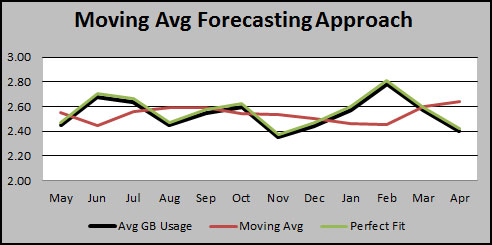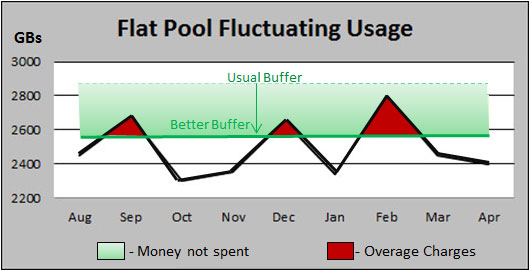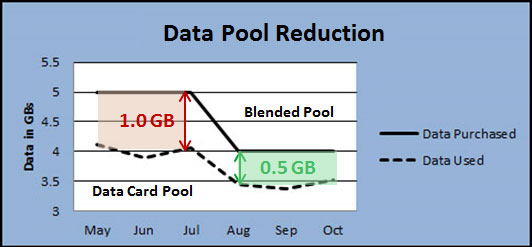Data Pools – Low Effort Forecasting Approach
Utilizing Moving Average May Be Good Enough
In last week’s tip we suggested that some data overage charges can actually be a good practice. This week we introduce a low effort approach for setting your data pooling levels. This approach can deliver results that are effective yet don’t require sophisticated forecasting methodologies. It is not uncommon to find some data pooling environments where you have no latitude to moderate your pool buffers – where your average pool usage falls well below the minimum attainable pool levels. Unfortunately in those cases you will always be paying for data you don’t need or use. Many, however, are going to find a mix of 2 and 5 GB level devices where your average usage fluctuates in a range yielding options for adjusting pool levels to lower costs by minimizing overage charges and payments for unused data. While MobilSense employs some sophisticated forecasting methods for both voice and data pools, when it comes to data pooling, using a simple moving average approach to setting pool levels may be good enough and is often better than setting your pool at a flat level year round based on the highest month’s peak usage.
Last week’s tip described a minimum effort approach of setting a flat pool level based on the expectation of incurring some month’s overage. Since data usage can be unpredictable, setting a flat level can lead to growing data overage charges particularly when overall data usage is rising over time and not just experiencing cyclical peaks and valleys. This week’s tip of using moving averages to set monthly pool levels introduces a low effort but more responsive approach to setting data pool levels.
This chart shows a situation where the average data usage per device is fluctuating between 2.4 GBs and 2.8 GBs. The perfect fit (green line) represents a result you will never achieve but reflects the absolute best you could ever do, matching your usage exactly. This chart represents a data pool of close to 1000 devices. The perfect fit cost for this pool would average $34,900/month. By contrast, the Moving Average (red line) results in an average monthly cost only slightly higher at $35,900/month. Through a simple monthly calculation, in this case moving average, this scenario comes within $1k/month of the theoretical minimum monthly cost.
Clearly defining a moving average formula is most easily done when you have a history of usage to draw upon. The pattern charted above reflects a quarterly rise and fall thus lending itself to a 3 month moving average, which is what was employed in this case. The number of months used in your averaging calculation should attempt to match the period of the peaks and valleys. For the chart above, the average usage for the period May through July determines the pool level that will be set for the August billing cycle, and then June through August determines September and the pattern continues. For the example above, a simple monthly calculation was used to set the subsequent month’s pool level while keeping the cost close to the theoretical minimum.


